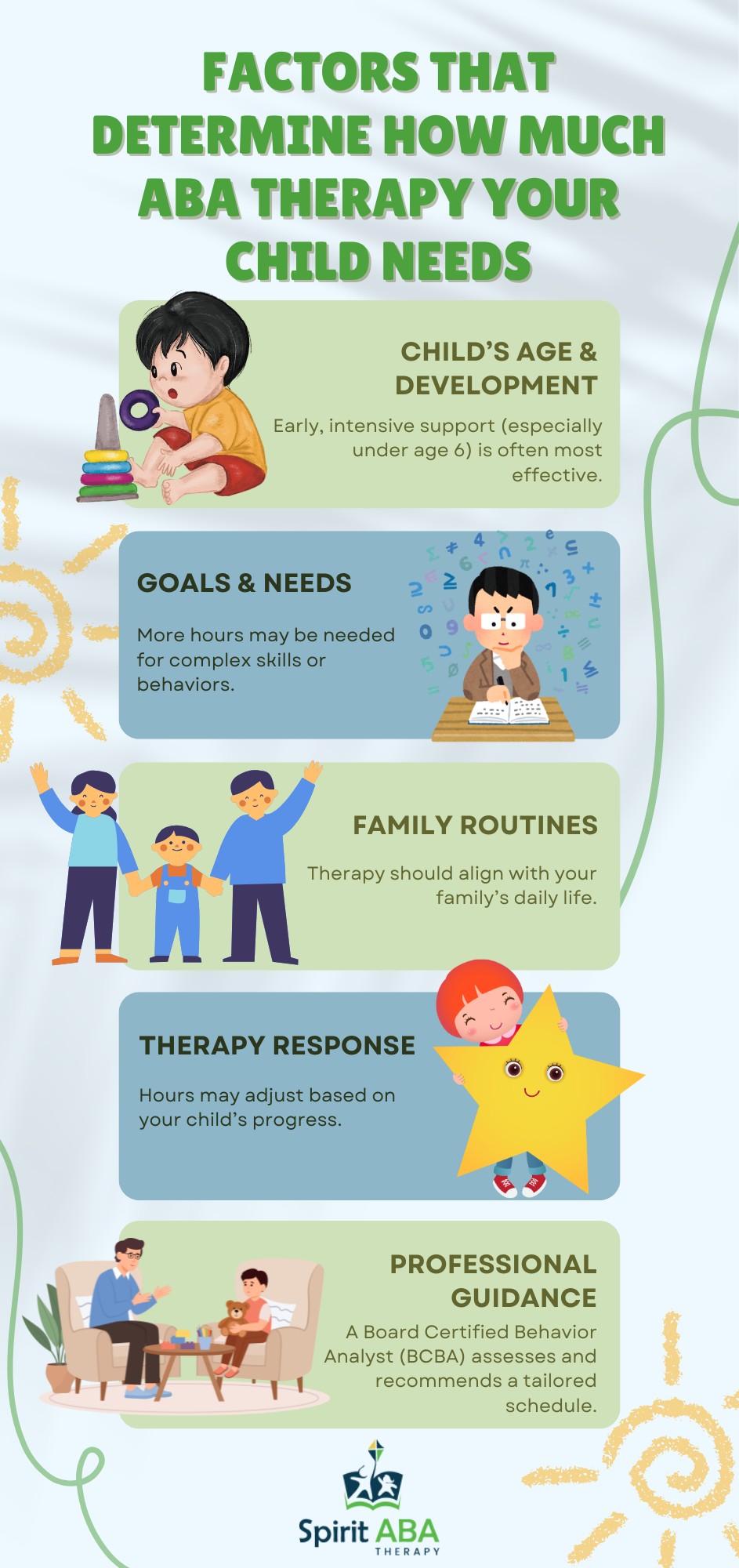Key Points:
- The amount of ABA therapy a child needs depends on their individual needs, goals, and family circumstances.
- Full-time (intensive) and part-time (focused) programs are the most common options, each with different benefits.
- Ongoing communication with your child’s care team helps adjust the therapy plan as progress is made.
It can feel overwhelming to figure out just how much support your child really needs. Parents often wonder if they’re doing too little—or too much—when it comes to ABA therapy. Here’s what to know about how much ABA therapy is needed and how to make confident, informed decisions.
How Much ABA Therapy Does Your Child Really Need?
Determining how much ABA therapy is needed depends on your child’s unique situation. There’s no one-size-fits-all number of hours because every child with autism has different strengths, challenges, and goals.
Some children benefit from a few hours a week, while others make the most progress with a more intensive program. Understanding the right amount starts with knowing what ABA therapy aims to accomplish: building meaningful skills, reducing harmful behaviors, and improving quality of life.
What is ABA Therapy?
Before deciding how much ABA therapy is needed, it helps to briefly understand what it involves. ABA, or Applied Behavior Analysis, is a scientifically proven therapy that helps children with autism learn and practice essential skills — like communication, self-care, play, and social interaction — in small, achievable steps. Therapy sessions can happen at home, at school, in a clinic, or out in the community.
ABA is most effective when it’s tailored to the child, which is why the number of hours and intensity of therapy may look very different from one child to another.
5 Factors That Determine How Much ABA Therapy Your Child Needs
Several important factors come into play when figuring out the right number of ABA hours for your child. These include:
Common ABA Therapy Schedules
When discussing how much ABA therapy is needed, professionals usually recommend one of two general approaches: intensive or focused.
Intensive (Full-Time) ABA Therapy
This is sometimes called comprehensive ABA therapy. It usually involves:
- Around 25–40 hours per week, spread over several days.
- Aimed at young children with many skill areas to develop.
- Works on a broad range of skills including language, social skills, play, and self-help, while also addressing challenging behaviors.
- Recommended particularly for children in early intervention (under age 6) or those with significant support needs.
Focused (Part-Time) ABA Therapy
Focused ABA therapy provides targeted support in specific areas of need. This usually involves:
- Around 10–20 hours per week, depending on the goals.
- Suitable for older children, or those who already have many foundational skills and just need help with particular behaviors or situations.
- Helps families who want to prioritize certain goals while balancing other activities, such as school or extracurriculars.
Both options can be adjusted over time based on how your child progresses.
 How to Know if Your Child Needs More or Fewer Hours
How to Know if Your Child Needs More or Fewer Hours
It’s natural to wonder if your child is getting “enough” therapy or if you’re overloading them. Look for these signs to help guide the decision:
- Your child is making steady progress: If they’re learning new skills and reducing problem behaviors at a pace that feels right, the hours may already be appropriate.
- Your child seems overwhelmed or fatigued: Too many hours might be tiring or counterproductive, especially if it disrupts family balance.
- Your child needs more support than current hours allow: If progress has slowed significantly or if there are still many areas to address, increasing therapy hours might help.
- Your BCBA recommends a change: Always talk through any concerns with your team — they can explain the reasoning behind suggested adjustments.
Tips for Parents Navigating ABA Therapy Hours
Deciding how much ABA therapy is needed isn’t easy, but you don’t have to figure it out alone. Here are some practical tips:
- Trust the assessment process: Your BCBA will assess your child’s skills and challenges and explain why they recommend a certain number of hours.
- Be realistic about family life: Think about how therapy fits into your routines and what your child can handle emotionally and physically.
- Stay involved and communicate often: Regularly check in with your BCBA and therapists to discuss progress and adjust the plan if needed.
- Celebrate progress, big or small: Whether your child attends 10 hours or 30 hours a week, every skill learned is meaningful.
When to Reassess Therapy Hours
ABA therapy isn’t meant to stay the same forever. Over time, as your child meets goals and becomes more independent, the number of hours can usually be reduced. Common times to reassess include:
- After completing a major skill milestone.
- At the end of a school year or other life transition.
- If your child seems ready for more independence or if their needs have changed significantly.
It’s perfectly normal for the intensity of therapy to shift over time.
Support Your Child’s Journey With Spirit ABA
Getting the right amount of ABA therapy helps your child maximize their potential while keeping them engaged and happy. Too little therapy might slow progress, while too much could lead to burnout. Working closely with a trusted provider ensures that therapy is effective, balanced, and personalized.
If you’re still wondering how much ABA therapy is needed for your child, Spirit ABA is here to help. With compassionate, experienced professionals, we provide individualized ABA therapy in Nebraska, Colorado, and Iowa to meet your child where they are and help them grow.
Whether you’re just starting out or reassessing your current plan, our team can guide you every step of the way. Reach out today to learn more about how we can support your family and help your child thrive.



